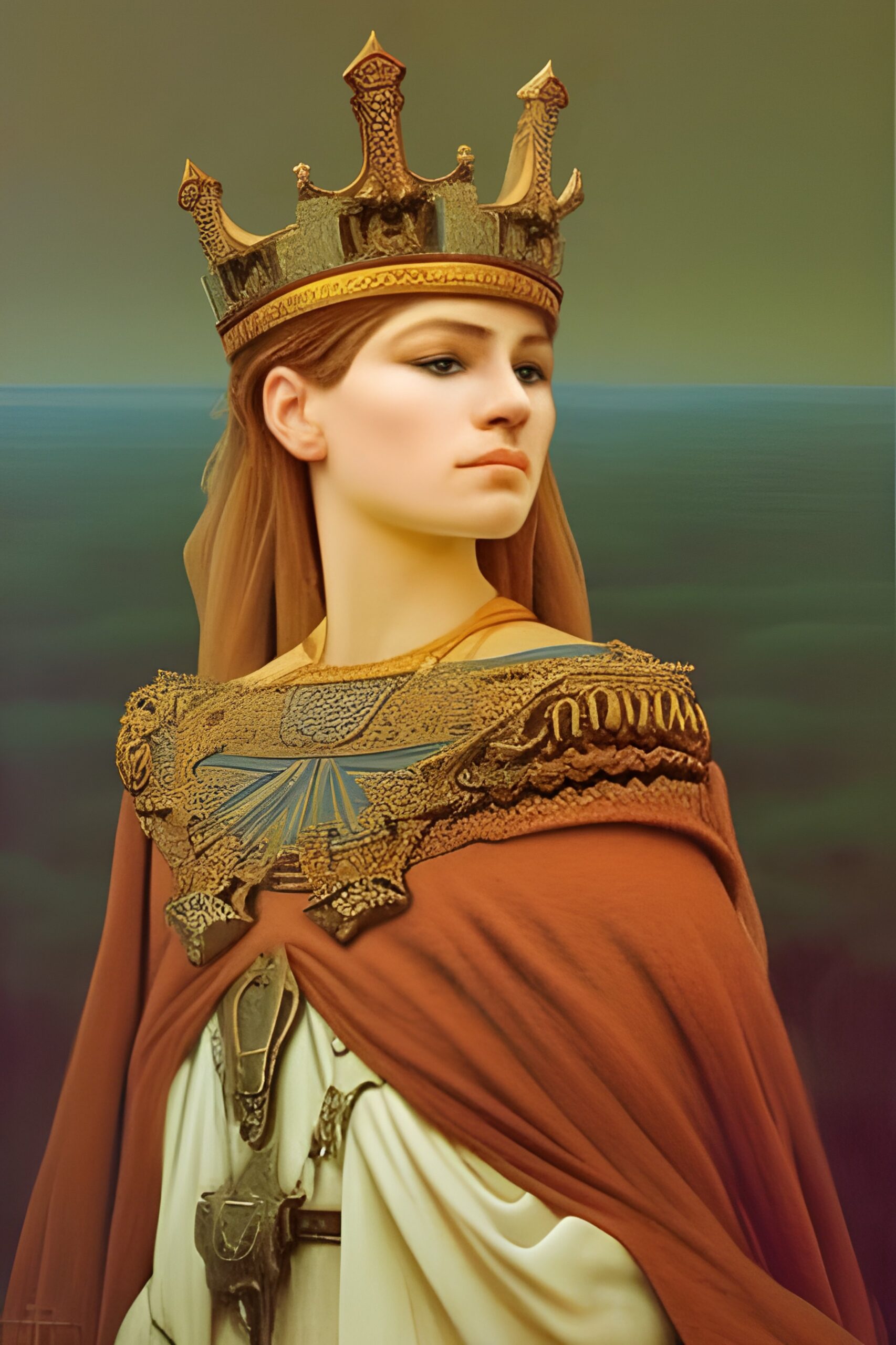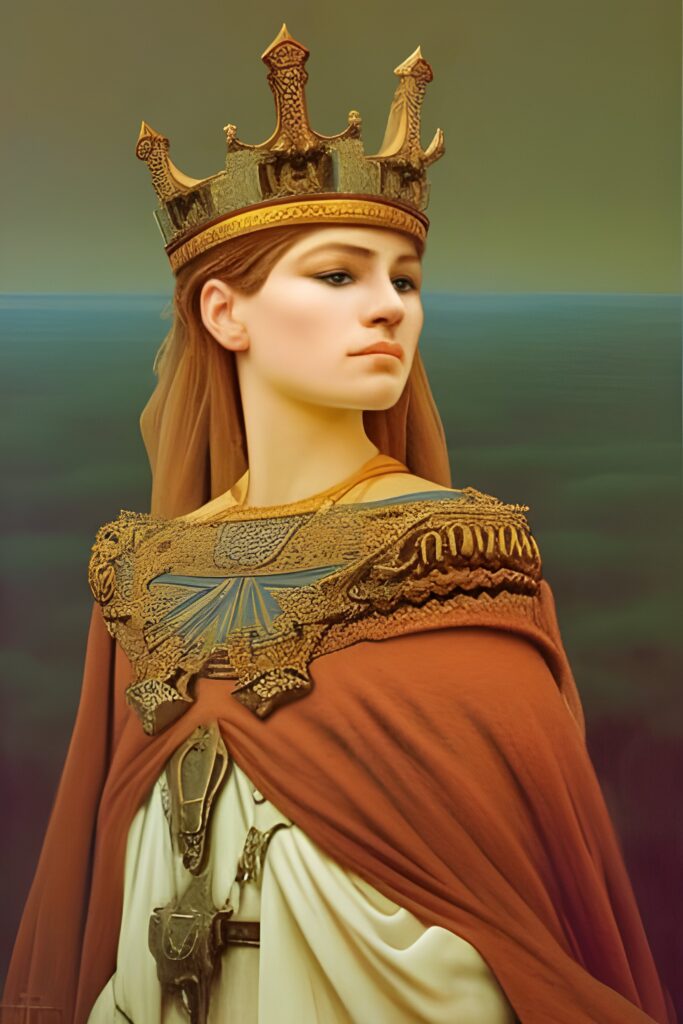Queen Baddo

Baddo (also known as Bauda) – fl. 589) was a 6th-century Visigoth queen consort. Queen Baddo is remarked for being the only Visigoth queen consort to have autographed sanctioned state and church documents, implying her involvement in politics and her authority over the government.
Queen Baddo was married to King Reccared the First( 580 – 601), who was King of Hispania and Septimania from 586 until 21 December 601. His reign marked a major turning point in history, with the king’s repudiation of Arianism in favour of Roman Christianity in 587.
Isidore of Seville
Historical records indicate that Baddo’s lineage might be first written about by Isidore of Seville. The primary sources on Baddo’s lineage are two works by this Spanish scholar and theologian: Historia de regibus Gothorum, Vandalorum et Suevorum and the Continuatio Byzantia-Arabica. The Historia de regibus Gothorum, Vandalorum et Suevorum (“History of the Kings of the Goths, Vandals and Suevi”) is a Latin history of the Goths from 265 to 624. The Continuatio Byzantia-Arabica is a historical text written in Latin, consisting of 43 sections or paragraphs. It was created between the years 741-743, during a period when a part of Spain was under Arab rule. Although many of the sections are relatively brief, the first 14 of them provide a concise account of the Visigothic monarchy up to the reign of Suintila (621-631), drawing from Isidore of Seville’s work, the Historia de regibus Gothorum, Vandalorum et Suevorum.
These two primary sources by Isidore of Seville both attest to the fact that Liuva II, born in 583 or 584, had a commoner mother who was one of Reccared’s concubines. Reccared was then the youngest son of Liuvigild, the Visigothic ruler at the time. Therefore, many scholars believe that the mother of Liuva II was queen Baddo. This would make Baddo the only known Visigoth queen consort to bear a royal son. However, some modern medievalists dispute Baddo’s lineage, claiming that marrying commoners was not a common practice among the Visigothic monarchy. Onomastic scholarship suggests that Baddo may have belonged to a noble Visigoth family with estates in the vicinity of Cordoba. The Visigoth kings Ervig and Egica are also thought to have come from this family.
On the basis of her name, with the Gothic Bat-element, one might think of a kinship with the lineages of the later kings Ervigius (died 687) and Ergica (died 702), whose roots are to be found in southern lands, especially in Cordoba and its countryside. A widespread hypothesis is that Baddo was unable to give birth to a son for Reccared the First and that the heir to the throne was declared to be Liuva II, born of one of the king’s concubines. This seems logical, as the latter was born in 584, before Baddo’s marriage, and it is documented that his mother was of humble origin. Nevertheless, it is clear that Baddo played an important role in the kingdom, and her influence over politics and the government cannot be ignored.
The exact date of Baddo’s marriage to Reccared the First is unknown. However, it is likely that the marriage took place after 584. In 579 or 582, Reccared the First was betrothed to the Frankish princess Rigunta, the daughter of King Chilperic I and Fredegonda. The marriage was supposed to be a dynastic union that would normalize relations between the Visigothic kingdom and the Frankish state. According to Gregory of Tours, Rigunta traveled to Spain in September 584, but due to the death of Chilperic I and the consequent new Visigothic-Frankish war, the marriage was never officially concluded. It has been suggested that Reccared the First may have married Baddo shortly after this failed attempt at a dynastic marriage.
However, the marriage between Reccared the First and Baddo likely occurred after his accession to the throne in 586. Shortly after his father’s death, Reccared the First attempted to marry Clodosinda, the daughter of the Frankish king Sigibert I and Brunnhilde. However, this marriage failed due to opposition from the King of Burgundy, Gunthramn. It is possible that Reccared the First married Baddo shortly after this failed attempt at another dynastic marriage. Alternatively, their marriage may have taken place in 589, which was the year that the Third Council of Toledo (marking the entry of Visigothic Spain into the Catholic Church) was held. Reccared the First presided over this council, which marked a significant turning point in the history of the Visigothic kingdom.
Third Council of Toledo
At the Third Council of Toledo, the Visigoths’ conversion to Arianism was officially recognized. The council was a landmark event that presented Reccared the First as a new Constantin (d. 337) and Marcian (d. 457), who had presided over the Councils of Nicaea (325) and Chalcedon (451) respectively. The council was considered to be the heir of previous ecumenical councils and was seen as a benchmark for the future. In a ceremony reminiscent of Byzantine style, Reccared the First, along with Queen Baddo, court nobles, and Arian bishops, publicly professed their conversion to the Catholic faith and renounced Arianism. The Catholic bishops and abbots expressed great joy and congratulated them. The council also established the foundation for a truly unified church within the Visigothic kingdom, where monarchy and episcopacy could work together in harmony.
The tomos adopted at the Third Council of Toledo was read in the Church of St Mary on May 8. Among other things, this document announced the earlier conversion of the monarchs to Nicene Christianity. This indicates that Baddo had previously professed Arianism. Among the other signatories to the council acts was Queen Baddo (Latin “Ego Baddo gloriosa regina hancfidem, quam credidi et suscepi, mea manu de toto corde subscribsi”). She is the only known Visigoth queen from medieval sources to have put her signature on the state and ecclesiastical documents of the Visigothic kingdom. This demonstrates the very large role Baddo played at her husband’s court. The Acts of the Third Council of Toledo are the only contemporary documents of Baddo that mention her name.
The date of Baddo’s death is not recorded in medieval sources. However, it is likely that she predeceased her husband, as there is no record of her being involved in the events of the later years of Reccared the First’s reign. It is unclear if Reccared the First remarried after her death. Based on an account in the World Chronicle by the 13th-century historian Luca of Tuy, some historians consider the youngest son of Reccared the First, who ruled the Visigoths from 621-631, to be Svintila. The mother of this monarch is referred to as a woman of unknown name. However, there is no other data on the relationship between Reccared the Firstand Svintila in medieval sources. King Reckared I died in December 601 and was succeeded by his son Liuva II. However, the latter was already murdered in 603 on the orders of Witterich, who became the new ruler of the Vestgothic kingdom.
Nachleben
The identity of Baddo, the wife of Visigothic king Reccared in the sixth century, has been a subject of speculation, particularly in relation to her alleged connection to King Arthur. While historians have previously believed that the idea of Baddo being Arthur’s offspring was a product of early modern writers, new evidence presented by Hélène Sirantoine traces the origins of this belief back to the Middle Ages. Although Baddo’s name does not appear in medieval sources, two hagiographical texts from the late thirteenth century, written in Zaragoza, depict the queen as the daughter of King Arthur. The manuscript transmission of these texts indicates that they were likely the source of early modern claims about Baddo’s Arthurian lineage. Hélène Sirantoine also analyzes the context and motivations behind the hagiographer’s decision to include Arthur in Visigothic genealogies, providing insights into the early circulation of Arthurian legends in the Iberian Peninsula.
The name Baddo also appears occasionally as a character in modern fanfiction, for example in the story “Learning from the past” by an author under the pseudonym “The Ancient Scribe”. This fanfiction features an original character named Baddo. She is a curious and intelligent girl who lives in the kingdom of Wessex, who discovers a stone with strange markings on it and brings it back to her village to show her parents. They tell her that the markings are a type of alphabet called Ogham, which was used by the ancient Irish. Baddo sets off to see King Alfred, the wise and kind ruler of Wessex known for his love of learning, in order to learn more about Ogham. She travels to the kingdom’s capital city and is allowed to see the king after impressing the guards with her determination and curiosity. King Alfred teaches Baddo about Ogham and invites her to his library to practise writing the letters. Baddo becomes skilled at writing Ogham and becomes known throughout the kingdom for her knowledge and passion for learning. King Alfred is remembered as a great king and champion of knowledge and education. As King Alfred has often been linked to King Arthur, this fanfiction indirectly reenforces the association of King Arthur and Baddo.

Leave a Reply